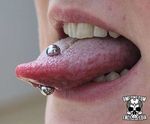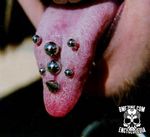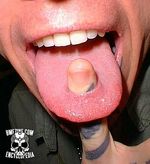Tongue Piercing
A tongue piercing is one of the most common, popular, and easy-to-heal piercings done.
There are two common reasons that might stop you from getting your tongue pierced. First, are overly prominent veins on the bottom of the tongue. Sometimes they can be avoided (so you may want to get a second opinion from an experienced piercer if you are told no), but there are rare cases where it would not be safe. The second thing that can make a tongue piercing difficult (or impossible) is an overly prominent tongue web. If it is too long and tight, you won't be able to stick out your tongue, making it difficult to pierce. In addition, a piercing might painfully rub on the webbing.
Contents
- Placement
- Procedure
- Healing and aftercare
- Long term health issues
- Jewelry
- History and culture
- Risks
- See also
- External links
Placement
They are generally done centrally and vertically through the body of the tongue. Off-center piercings are also a valid option, as is the much rarer horizontal tongue piercing. Other rare placements include tongue orbitals and other tongue surface piercings. Related piercings include the tongue web piercing. Tongue piercings are generally considered very useful for oral sex; although that's definitely not the only reason people get the piercing! The location of the piercing should match the style of oral sex you will be performing... Some people find that piercings closer to the tip work well if you will be performing oral sex on women, with deeper piercings being slightly better for men.
Procedure
Some piercers make the claim that tongue piercings should be pierced from the bottom up. Most do not, and to be blunt, it doesn't make a whole lot of difference. It's just the personal preference of the piercer.
Healing and aftercare
When a tongue piercing is first done, a great deal of swelling occurs, which usually lasts as much as a week (some people find this first week very painful to the point where sleeping is difficult, but most people experience very little pain from tongue piercing). Total healing time is about a month, during which aftercare is limited to occasionally rinses with either salt water or a mild mouthwash.
Long term health issues
Tongue piercings carry with them almost no infection or risks directly related to the piercing (like cancer), but they do carry a large risk of tooth chipping; after all, if you bite down hard on a steel bead, what do you think will happen to your tooth? However, the risk of chipped teeth can be almost totally eliminated by wearing properly sized jewelry. For healing and initial piercing, the tongue jewelry should be 50% longer than the thickness of the tongue (normally this is 3/4"), but once healed it is very important that a shorter bar be installed.
It should be noted that tongue piercing can (indirectly) lead to death. For example, if you get in a car accident, are brought to the hospital, and need a breathing tube inserted, it can be blocked by the tongue jewelry. If the doctors are inexperienced in dealing with piercings, this can mean no breathing tube. Even if they are, it can delay the breathing tube long enough to leave you with brain damage. While this only affects a tiny percentage of people who get their tongues pierced, it is important to think about these indirect risks with all piercings.
Jewelry
Most tongue piercings are performed using a straight barbell in 14ga to 10ga using a standard needle piercing procedure. Other piercers have performed this piercing using a scalpel, cutting lengthwise along the grain of the tongue to install 2ga or 0ga initial jewelry, usually a Teflon plug or even wooden jewelry; other people choose to stretch to these sizes. In the larger sizes, people may choose to wear hollow barbells with smartie beads to reduce the weight and stress on the surrounding tissue.
History and culture
In the modern historical sense, the piercing was "first" done on Tattoo Samy, a German artist, using a 10ga Dermal Punch in 1978 (documented in PFIQ if memory serves). In addition, the Ripley's Archive contains photos of sideshow performers not long into the 20th century wearing barbells in what appear to be healed tongue piercings. Paul King adds,
- The tongue has a long history of temporary piercing for religious and performance practices. We know Mesoamericans such as the Aztecs practiced tongue piercing as well as other perforations as a part of blood offerings to their deities. Islamic Fakirs and Sufis from the Middle East, and Asian Spirit Mediums of the Far East practiced tongue piercing as an offering and proof of trance state. The reason for the central Aboriginal Australian holy man's practice of piercing the tongue remains unknown.
- From the turn of the 20th century, Western Carnies borrowed many of their sideshow tricks from fakirs bringing to American and European audiences their first glimpses of tongue piercing. Elayne Angel is largely responsible for the popularity of tongue piercing today; she is credited with being the first person with a tongue tip and multiple tongue piercings.
Risks
See also
- Tongue
- Horizontal Tongue Piercing
- Tongue Surface Piercing
- Tongue Web Piercing
- Tongue Rim Piercing
- Tongue Splitting




